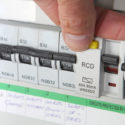
Safety switch ‘may have saved’ Pyengana worker’s life
23/01/2020
Industrial Manslaughter Update
02/06/2021What is an earthed appliance?
What is the difference between an earthed and non-earthed appliance and why is it important?
Early forms of electrical supply and appliance wiring had only two wires; an active and a neutral. This is still common in many countries today.
The wires (conductors) are covered with a layer of insulation. Insulation is a material that has high electrical resistance qualities and is used in electrical appliances to prevent the flow of current through it and protect people from electric shock.
In Australia, and many countries, a third conductor commonly called the earth or ground is included in the wiring of buildings (commercial and residential) and in some appliances. This third conductor is connected to the earth contact within the power outlets which in turn are connected to the “earth bar” in the main switch board which in turn is connected to a metal stake inserted into the ground outside the building. This is called a protective earthThe protective earth is a system to provide additional protection against electric shock. It is present in Class I appliances, extension leads and powerboards. More system.
How does this protect you from electric shock?
An electric appliance with a protective earthThe protective earth is a system to provide additional protection against electric shock. It is present in Class I appliances, extension leads and powerboards. More incorporated into the design has an extra conductor known as the “earth conductor”. One end of the earth conductor is connected to the metal chassis of the appliance, the other end is connected to the earth pin on the supply lead plug. These are called Class 1 or earthed appliances.
Should the appliance develop an electrical defect and chassis becomes “live”, rather than flowing through the user and delivering them an electric shock, the current in the chassis flows through the protective earthThe protective earth is a system to provide additional protection against electric shock. It is present in Class I appliances, extension leads and powerboards. More system to the earth stake and safely dissipate, thereby protecting the user from an electric shock. The user may not even know this is happening.
In order for this to work effectively, the amount of electrical resistance in the entire protective earthThe protective earth is a system to provide additional protection against electric shock. It is present in Class I appliances, extension leads and powerboards. More system must be very low.
Where does testing and tagging come into this?
As part of the test and tag process, the technician must check the integrity of the protective earthThe protective earth is a system to provide additional protection against electric shock. It is present in Class I appliances, extension leads and powerboards. More in Class 1 appliances to ensure it is providing effective protection against electric shock. The test verifies the resistance between the chassis of the appliance and the earth pin. It must not be any greater than 1Ω. Any higher and the appliance must be given a fail outcome.
What about appliances without a protective earthThe protective earth is a system to provide additional protection against electric shock. It is present in Class I appliances, extension leads and powerboards. More?
Non-earthed appliance are called Class 2 appliances and also have two levels of protection against electric shock.
The first level is the insulation around the conductors. The second is typically a chassis made of a non-conductive material that has very high insulating qualities. This is why they are called double insulated appliances.




